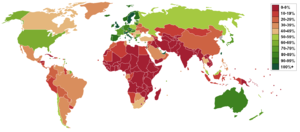- Image via Wikipedia
Mobile Phones for Women:
Telecoms, nongovernmental organizations (NGOs) and nonprofits are pushing to put mobile phones directly in the hands of women in low- and middle-income countries.
Enas Salameh, a 24-year-old college graduate living in the Palestinian West Bank city of Jenin, needed a job this summer. But her family finds it unacceptable for a woman to venture alone into the city without a male companion or an appointment. Fortunately, it’s fine to use a mobile phone. In fact, although only 16 percent of Palestinian households have Internet access, 81 percent have a cell phone, according to a 2009 United Nations report. Salameh was thus able to sign up for a text message–based job-matching program sponsored by a service called Souktel. She posted a “mini-resume,” browsed for suitable jobs via text messages, and then interviewed in person after an appointment was set. On September 22nd, she started a data-entry job with the German aid agency GTZ.
Although the job does not take advantage of her training in physical therapy, “this is better than staying at home,” she says through a translator, “and I think that I am gaining new experiences to be a useful woman in my community.” Without mobile phones, says Souktel co-founder Jacob Korenblum, a lot of the approximately 750 women worldwide who have work through the program would still be unemployed.
Mobile technology was available to Salameh, but that’s often not the case for women. A 2010 report by London-based telecom industry advocacy group GSMA (for Groupe Speciale Mobile Association) and the Cherie Blair Foundation for Women found a “mobile gender gap” in low- and middle-income countries: women are 21 percent less likely than men to own a mobile phone. The rate is highest in Asia, at 37 percent. Once they get phones women nearly uniformly report feeling safer, more connected and more independent. Nearly half say the phones help increase income and professional opportunities.
So, in October GSMA launched the “mWomen Program,” with support from Cherie Blair and Secretary of State Hillary Clinton (“mWomen” is for mobile women). The goal is to half the number of women in the developing world who lack mobile phones within three years by putting phones in the hands of another 150 million women.
GSMA’s mWomen working group met in Chennai, India, in early November. Twenty-three organizations, including the telecom Ericsson, representing 115 developing countries committed to the project. And the program’s recently announced “app challenge“—which solicits apps for simple cell phones and smart phones that can help to address the needs of women living at the “base of the pyramid” in the developing world—has received dozens of entries, including one from Souktel.
But first, women need the phones to run these apps. The working group is therefore examining various business models and marketing tools to overcome cultural, educational and financial barriers. So far, ideas include using direct marketing models similar to those developed by Avon or Tupperware to put women in charge of selling to women and hire only women to serve as customer service representatives for telecoms’ female customers, says Trina DasGupta, mWomen program director at GSMA.










